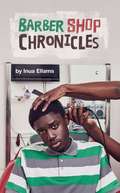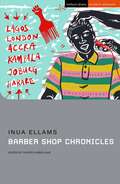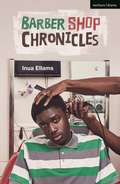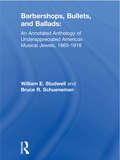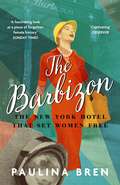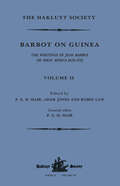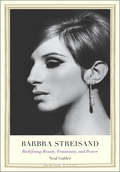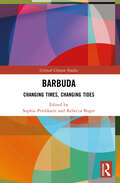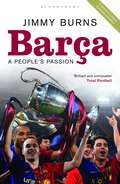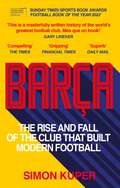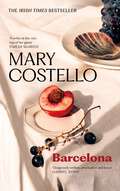- Table View
- List View
Barber Shop Chronicles (Oberon Modern Plays)
by Inua EllamsOne day. Six cities. A thousand stories. Newsroom, political platform, local hot spot, confession box, preacher-pulpit and football stadium. For generations, African men have gathered in barber shops to discuss the world.
Barber Shop Chronicles (Student Editions)
by Inua EllamsNewsroom, political platform, local hot spot, confession box, preacher-pulpit and football stadium. For generations, African men have gathered in barber shops to discuss the world. These are places where the banter can be barbed and the truth is always telling.Barber Shop Chronicles, which was partly inspired by verbatim recordings, is a heart-warming, hilarious and insightful play that leaps from a barber shop in Peckham to Johannesburg, Harare, Kampala, Lagos and Accra over the course of a single day.It was first produced by the National Theatre, Fuel and Leeds Playhouse in 2017 and is here publishedas a Methuen Drama Student Edition with commentary and notes by Oladipo Agboluaje.
Barber Shop Chronicles (Modern Plays)
by Inua EllamsBarber Shop Chronicles is a generously funny, heart-warming and insightful new play set in five African cities, Johannesburg, Harare, Kampala, Lagos, Accra, and in London.Inspired in part by the story of a Leeds barber, the play invites the audience into a unique environment where the banter may be barbed, but the truth always telling. The barbers of these tales are sages, role models and father figures who keep the men together and the stories alive.Inua Ellams's celebrated play was first produced by the National Theatre, Fuel and Leeds Playhouse in 2017.
Barber Shop Chronicles (Modern Plays)
by Inua EllamsBarber Shop Chronicles is a generously funny, heart-warming and insightful new play set in five African cities, Johannesburg, Harare, Kampala, Lagos, Accra, and in London.Inspired in part by the story of a Leeds barber, the play invites the audience into a unique environment where the banter may be barbed, but the truth always telling. The barbers of these tales are sages, role models and father figures who keep the men together and the stories alive.Inua Ellams's celebrated play was first produced by the National Theatre, Fuel and Leeds Playhouse in 2017.
Barber Shop Chronicles (Student Editions)
by Inua EllamsNewsroom, political platform, local hot spot, confession box, preacher-pulpit and football stadium. For generations, African men have gathered in barber shops to discuss the world. These are places where the banter can be barbed and the truth is always telling.Barber Shop Chronicles, which was partly inspired by verbatim recordings, is a heart-warming, hilarious and insightful play that leaps from a barber shop in Peckham to Johannesburg, Harare, Kampala, Lagos and Accra over the course of a single day.It was first produced by the National Theatre, Fuel and Leeds Playhouse in 2017 and is here publishedas a Methuen Drama Student Edition with commentary and notes by Oladipo Agboluaje.
The Barber's Clever Wife: A Bloomsbury Reader (Bloomsbury Readers)
by Narinder DhamiA funny retelling of an Indian folk tale from best-selling author Narinder Dhami.Bulbul would much rather sit at home under the mango tree than go to work. And anyway everyone in the village agrees that he is the worst barber in the whole world. Luckily his wife Ruby has a cunning plan to earn money – but first they must outwit a notorious band of thieves!This comical version of a traditional Indian story from best-selling author Narinder Dhami has entertaining black-and-white illustrations by TBC and is perfect for children who are developing as readers. The Bloomsbury Readers series is packed with brilliant books to get children reading independently in Key Stage 2, with book-banded stories by award-winning authors like double Carnegie Medal winner Geraldine McCaughrean and Waterstones Prize winner Patrice Lawrence, covering a wide range of genres and topics. With charming illustrations and online guided reading notes written by the Centre for Literacy in Primary Education (CLPE), this series is ideal for reading both in the classroom and at home. For more information visit www.bloomsburyguidedreading.com.Book Band: BrownIdeal for ages 8+
The Barber's Clever Wife: A Bloomsbury Reader (Bloomsbury Readers)
by Narinder DhamiA funny retelling of an Indian folk tale from best-selling author Narinder Dhami.Bulbul would much rather sit at home under the mango tree than go to work. And anyway everyone in the village agrees that he is the worst barber in the whole world. Luckily his wife Ruby has a cunning plan to earn money – but first they must outwit a notorious band of thieves!This comical version of a traditional Indian story from best-selling author Narinder Dhami has entertaining black-and-white illustrations by TBC and is perfect for children who are developing as readers. The Bloomsbury Readers series is packed with brilliant books to get children reading independently in Key Stage 2, with book-banded stories by award-winning authors like double Carnegie Medal winner Geraldine McCaughrean and Waterstones Prize winner Patrice Lawrence, covering a wide range of genres and topics. With charming illustrations and online guided reading notes written by the Centre for Literacy in Primary Education (CLPE), this series is ideal for reading both in the classroom and at home. For more information visit www.bloomsburyguidedreading.com.Book Band: BrownIdeal for ages 8+
Barbershops, Bibles, and BET: Everyday Talk and Black Political Thought
by Melissa Victoria Harris-LacewellWhat is the best way to understand black political ideology? Just listen to the everyday talk that emerges in public spaces, suggests Melissa Harris-Lacewell. And listen this author has--to black college students talking about the Million Man March and welfare, to Southern, black Baptists discussing homosexuality in the church, to black men in a barbershop early on a Saturday morning, to the voices of hip-hop music and Black Entertainment Television. Using statistical, experimental, and ethnographic methods Barbershops, Bibles, and B.E.T offers a new perspective on the way public opinion and ideologies are formed at the grassroots level. The book makes an important contribution to our understanding of black politics by shifting the focus from the influence of national elites in opinion formation to the influence of local elites and people in daily interaction with each other. Arguing that African Americans use community dialogue to jointly develop understandings of their collective political interests, Harris-Lacewell identifies four political ideologies that constitute the framework of contemporary black political thought: Black Nationalism, Black Feminism, Black Conservatism and Liberal Integrationism. These ideologies, the book posits, help African Americans to understand persistent social and economic inequality, to identify the significance of race in that inequality, and to devise strategies for overcoming it.
Barbershops, Bibles, and BET: Everyday Talk and Black Political Thought (PDF)
by Melissa Victoria Harris-LacewellWhat is the best way to understand black political ideology? Just listen to the everyday talk that emerges in public spaces, suggests Melissa Harris-Lacewell. And listen this author has--to black college students talking about the Million Man March and welfare, to Southern, black Baptists discussing homosexuality in the church, to black men in a barbershop early on a Saturday morning, to the voices of hip-hop music and Black Entertainment Television. Using statistical, experimental, and ethnographic methods Barbershops, Bibles, and B.E.T offers a new perspective on the way public opinion and ideologies are formed at the grassroots level. The book makes an important contribution to our understanding of black politics by shifting the focus from the influence of national elites in opinion formation to the influence of local elites and people in daily interaction with each other. Arguing that African Americans use community dialogue to jointly develop understandings of their collective political interests, Harris-Lacewell identifies four political ideologies that constitute the framework of contemporary black political thought: Black Nationalism, Black Feminism, Black Conservatism and Liberal Integrationism. These ideologies, the book posits, help African Americans to understand persistent social and economic inequality, to identify the significance of race in that inequality, and to devise strategies for overcoming it.
Barbershops, Bullets, and Ballads: An Annotated Anthology of Underappreciated American Musical Jewels, 1865-1918
by William E Studwell Bruce R SchuenemanThrough Barbershops, Bullets, and Ballads: An Annotated Anthology of Underappreciated American Musical Jewels, 1865--1918, you will discover older musical gems written during a half-century period of geographical, economic, political, and cultural expansion in the United States. Due to the fact that our collective American consciousness is rapidly developing cultural amnesia about or indifference to many of these older songs, the authors felt that a scholarly anthology needed to be produced before another century and millennium overwhelmed us. With Barbershops, Bullets, and Ballads, you will discover academic composers such as Arthur Foote, George Chadwick, and Amy Beach and find annotations outlining the history of the songs as well as the actual words and music.Barbershops, Bullets, and Ballads reveals to you such underappreciated songs as: “Above in Her Chamber,” with music by Julius Eichberg and lyrics by poet Celia Thaxter “In the Evening by the Moonlight,” with music and lyrics by James A. Bland “My Wild Irish Rose,” with music and lyrics by Chauncey Olcott “Cheyenne,” by lyricist Harry H. Williams and composer Egbert Van Alstyne “Come, Josephine in My Flying Machine,” with music by Fred Fisher and lyrics by Alfred BryanIn Barbershops, Bullets, and Ballads, you will find sections containing historical notes of featured songs in chronological order. Through this remarkable collection, you will discover an anthology of popular music of the bygone “golden age” of song and take a pleasurable voyage back to a time that is long gone.
Barbershops, Bullets, and Ballads: An Annotated Anthology of Underappreciated American Musical Jewels, 1865-1918
by William E Studwell Bruce R SchuenemanThrough Barbershops, Bullets, and Ballads: An Annotated Anthology of Underappreciated American Musical Jewels, 1865--1918, you will discover older musical gems written during a half-century period of geographical, economic, political, and cultural expansion in the United States. Due to the fact that our collective American consciousness is rapidly developing cultural amnesia about or indifference to many of these older songs, the authors felt that a scholarly anthology needed to be produced before another century and millennium overwhelmed us. With Barbershops, Bullets, and Ballads, you will discover academic composers such as Arthur Foote, George Chadwick, and Amy Beach and find annotations outlining the history of the songs as well as the actual words and music.Barbershops, Bullets, and Ballads reveals to you such underappreciated songs as: “Above in Her Chamber,” with music by Julius Eichberg and lyrics by poet Celia Thaxter “In the Evening by the Moonlight,” with music and lyrics by James A. Bland “My Wild Irish Rose,” with music and lyrics by Chauncey Olcott “Cheyenne,” by lyricist Harry H. Williams and composer Egbert Van Alstyne “Come, Josephine in My Flying Machine,” with music by Fred Fisher and lyrics by Alfred BryanIn Barbershops, Bullets, and Ballads, you will find sections containing historical notes of featured songs in chronological order. Through this remarkable collection, you will discover an anthology of popular music of the bygone “golden age” of song and take a pleasurable voyage back to a time that is long gone.
Barbie Culture
by Professor Mary F. RogersThis book uses one of the most popular accessories of childhood, the Barbie doll, to explain key aspects of cultural meaning. Some readings would see Barbie as reproducing ethnicity and gender in a particularly coarse and damaging way - a cultural icon of racism and sexism. Rogers develops a broader, more challenging picture. She shows how the cultural meaning of Barbie is more ambiguous than the narrow, appearance-dominated model that is attributed to the doll. For a start, Barbie's sexual identity is not clear-cut. Similarly her class situation is ambiguous. But all interpretations agree that, with her enormous range of lifestyle `accessories', Barbie exists to consume. Her body is the perfect metaphor of modern times: plastic, standardized and oozing fake sincerity.
The Barbier Reaction and Related One-Step Processes (Reactivity and Structure: Concepts in Organic Chemistry #31)
by Cornelis BlombergThe significant increase in applications of Barbier and Barbier-type reactions in (in-) organic synthesis over the past twenty-five years, combined with repeated stimulation on the part of Springer-Verlag (Dr. R. Stumpe) were strong in centives for me to write this book. My earliest activities in this field include a modest and first-ever review article (in cooperation with Dr. F. A. Hartog who at that time (1977) did his doctoral research on the Barbier reaction). References to this review article, as mentioned in the Science Citation Index till recently are a good indication for a continued interest in this simple synthetic procedure. The subtitle of this monograph, Related One-Step Processes, may require the following clarification. A synthesis with the aid of an organometallic compound is usually carried out in two steps: 1) the organometallic reagent is prepared from an organo halide and a metal in a solvent, 2) a chosen substrate is added to this reagent. In a Barbier reaction these two steps are combined: a mixture of the organo halide and the substrate is added to a suspension of the metal-in an appropriate solvent.
The Barbizon: The New York Hotel That Set Women Free
by Paulina Bren'Captivating... [explores] the changing cultural perceptions of women's ambition, set against the backdrop of that most famous theatre of aspiration, New York City' NEW YORK TIMESWELCOME TO THE BARBIZON, NEW YORK'S PREMIER WOMEN-ONLY HOTEL Built in 1927, New York's Barbizon Hotel was first intended as a home for the 'Modern Woman' seeking a career in the arts. It became the place to stay for ambitious, independent women, who were lured by the promise of fame and good fortune. Sylvia Plath fictionalized her time there in The Bell Jar, and over the years, its 688 tiny pink 'highly feminine boudoirs' also housed Joan Crawford, Grace Kelly (notorious for sneaking in men), Joan Didion, Candice Bergen, Charlie's Angel Jaclyn Smith, Ali MacGraw, Cybil Shepherd, Elaine Stritch, Liza Minnelli, Eudora Welty, The Cosby Show's Phylicia Rashad, and writers Mona Simpson and Ann Beattie, among many others. Mademoiselle boarded its summer interns there - perfectly turned-out young women, who would never be spotted hatless - as did Katherine Gibbs Secretarial School its students - in their white-gloves and kitten heels - and the Ford Modelling Agency its young models. Not everyone who passed through the Barbizon's doors was destined for greatness - for some it was a story of dashed hopes and expectations - but from the Jazz Age New Women of the 1920s, to the Liberated Women of the 1960s, until 1981 when the first men checked in, The Barbizon was a place where women could stand up and be counted. THE BARBIZON is a colourful, glamorous portrait of the lives of these young women, who came to New York looking for something more. It's a story of pushing the boundaries, of women's emancipation and of the generations of brilliant women who passed through its halls.
Barbot on Guinea: Volume II
by Adam JonesJean Barbot, who served as a commercial agent on French slave-trading voyages to West Africa in 1678-9 and 1681-2, in 1683 began an account of the Guinea coast, based partly on his voyage journals (only one of which is extant) and partly on previous printed sources. The work was interrupted by his flight to England, as a Huguenot refugee, in 1685, and not finished until 1688. When Barbot found that his lengthy French account could not be published, he rewrote it in English, enlarging it even further, and then continually revising it up to his death in 1712. The manuscript was eventually published in 1732. Barbot's book had considerable influence on later European attitudes to Black Africa and the Atlantic slave trade and in modern writings on both subjects is frequently cited as evidence. The French account serves as the base for the present edition and is presented in English translation but additional material in the later English version is inserted. The edition concentrates on Barbot's original information. He copied much from earlier sources - this derived material is omitted but is identified in the notes. The original material, mainly on Senegal, Sierra Leone, River Sess, Gold Coast and the Calabars, is extensively annotated, not least with comparative references to other sources. Apart from its narrative interest, the edition thus provides a starting point for the critical assessment of a range of early sources on Guinea. The edition opens with an introductory essay discussing Barbot's life and career and analysing his sources. Barbot provided a large number of his own drawings of topographical and ethnographical features, in particular drawings of almost all of the European forts in Guinea. Many of these illustrations are reproduced. This volume covers the coast from the River Volta to Cape Lopez. The main pagination of this and the previous volume (2nd series 175) series is continuous. This is a new print-on-demand hardback edition of the volume first published in 1991.
Barbot on Guinea: Volume II
by Adam JonesJean Barbot, who served as a commercial agent on French slave-trading voyages to West Africa in 1678-9 and 1681-2, in 1683 began an account of the Guinea coast, based partly on his voyage journals (only one of which is extant) and partly on previous printed sources. The work was interrupted by his flight to England, as a Huguenot refugee, in 1685, and not finished until 1688. When Barbot found that his lengthy French account could not be published, he rewrote it in English, enlarging it even further, and then continually revising it up to his death in 1712. The manuscript was eventually published in 1732. Barbot's book had considerable influence on later European attitudes to Black Africa and the Atlantic slave trade and in modern writings on both subjects is frequently cited as evidence. The French account serves as the base for the present edition and is presented in English translation but additional material in the later English version is inserted. The edition concentrates on Barbot's original information. He copied much from earlier sources - this derived material is omitted but is identified in the notes. The original material, mainly on Senegal, Sierra Leone, River Sess, Gold Coast and the Calabars, is extensively annotated, not least with comparative references to other sources. Apart from its narrative interest, the edition thus provides a starting point for the critical assessment of a range of early sources on Guinea. The edition opens with an introductory essay discussing Barbot's life and career and analysing his sources. Barbot provided a large number of his own drawings of topographical and ethnographical features, in particular drawings of almost all of the European forts in Guinea. Many of these illustrations are reproduced. This volume covers the coast from the River Volta to Cape Lopez. The main pagination of this and the previous volume (2nd series 175) series is continuous. This is a new print-on-demand hardback edition of the volume first published in 1991.
Barbra Streisand: Redefining Beauty, Femininity, and Power (Jewish Lives)
by Neal GablerBarbra Streisand has been called the “most successful...talented performer of her generation” by Vanity Fair, and her voice, said pianist Glenn Gould, is “one of the natural wonders of the age.” Streisand scaled the heights of entertainment—from a popular vocalist to a first-rank Broadway star in Funny Girl to an Oscar-winning actress to a producer and director. But she has also become a cultural icon who has transcended show business. To achieve her success, Brooklyn-born Streisand had to overcome tremendous odds, not the least of which was her Jewishness. Dismissed, insulted, even reviled when she embarked on a show business career for acting too Jewish and looking too Jewish, she brilliantly converted her Jewishness into a metaphor for outsiderness that would eventually make her the avenger for anyone who felt marginalized and powerless. Neal Gabler examines Streisand’s life and career through this prism of otherness—a Jew in a gentile world, a self-proclaimed homely girl in a world of glamour, a kooky girl in a world of convention—and shows how central it was to Streisand’s triumph as one of the voices of her age.
Barbuda: Changing Times, Changing Tides (Critical Climate Studies)
by Sophia Perdikaris Rebecca BogerThis volume explores a range of themes including impacts of climate change, resilience, sustainability, indigeneity, cultural genocide, disaster capitalism, preservation of biodiversity, and environmental degradation. Focusing on the island of Barbuda in the West Indies, it shares critical insights into how climate change is reshaping our world. The book examines how climate has changed in the Caribbean over different spatial and temporal scales and how varying natural and anthropogenic factors have shaped Barbuda’s climatic and cultural history. It highlights projections of 21st-century climate change for the Caribbean region and its likely impacts on Barbuda’s coastal ecosystems, potable groundwater resources, and heritage. With essays by researchers from the United States, Canada, Caribbean, and Europe, this volume straddles a range of disciplines such as archaeology, anthropology, paleoclimatology, environmental sciences, science education, and Traditional Ecological Knowledge (TEK). Drawing on interdisciplinary and transdisciplinary approaches that explore the intersection of natural and social systems over the longue durée, the volume will be of interest to scholars, researchers, and students of ethnography, social anthropology, climate action, development studies, public policy, and climate change.
Barbuda: Changing Times, Changing Tides (Critical Climate Studies)
by Sophia Perdikaris and Rebecca BogerThis volume explores a range of themes including impacts of climate change, resilience, sustainability, indigeneity, cultural genocide, disaster capitalism, preservation of biodiversity, and environmental degradation. Focusing on the island of Barbuda in the West Indies, it shares critical insights into how climate change is reshaping our world. The book examines how climate has changed in the Caribbean over different spatial and temporal scales and how varying natural and anthropogenic factors have shaped Barbuda’s climatic and cultural history. It highlights projections of 21st-century climate change for the Caribbean region and its likely impacts on Barbuda’s coastal ecosystems, potable groundwater resources, and heritage. With essays by researchers from the United States, Canada, Caribbean, and Europe, this volume straddles a range of disciplines such as archaeology, anthropology, paleoclimatology, environmental sciences, science education, and Traditional Ecological Knowledge (TEK). Drawing on interdisciplinary and transdisciplinary approaches that explore the intersection of natural and social systems over the longue durée, the volume will be of interest to scholars, researchers, and students of ethnography, social anthropology, climate action, development studies, public policy, and climate change.
Barbury Castle crop circle (Large Print)
by RnibThis crop circle was found in 1991 near Avebury in Wiltshire. There is a locator dot shown, which will be at the top left of the page when the image is the right way up. Centrally placed towards the top of the page is a circle divided into six by curved lines; it rests on the top point of a triangle. A line leads straight down from the point, intersecting with two concentric rings and a solid disc in the centre of the page. Two more straight lines lead down left and right to the bottom corners of the triangle. A circle touches the lower left point of the triangle, and a ratchet spiral shape touches its lower right point at the bottom of the page.
Barbury Castle crop circle (UEB Contracted)
by RnibThis crop circle was found in 1991 near Avebury in Wiltshire. There is a locator dot shown, which will be at the top left of the page when the image is the right way up. Centrally placed towards the top of the page is a circle divided into six by curved lines; it rests on the top point of a triangle. A line leads straight down from the point, intersecting with two concentric rings and a solid disc in the centre of the page. Two more straight lines lead down left and right to the bottom corners of the triangle. A circle touches the lower left point of the triangle, and a ratchet spiral shape touches its lower right point at the bottom of the page.
Barbury Castle crop circle (UEB Uncontracted)
by RnibThis crop circle was found in 1991 near Avebury in Wiltshire. There is a locator dot shown, which will be at the top left of the page when the image is the right way up. Centrally placed towards the top of the page is a circle divided into six by curved lines; it rests on the top point of a triangle. A line leads straight down from the point, intersecting with two concentric rings and a solid disc in the centre of the page. Two more straight lines lead down left and right to the bottom corners of the triangle. A circle touches the lower left point of the triangle, and a ratchet spiral shape touches its lower right point at the bottom of the page.
Barca: A People's Passion (reissued)
by Jimmy BurnsFounded in 1898, FC Barcelona or Barça, is the world's biggest and best-loved football club. Barça has more than 500 local fan clubs spread across the world, while its championship matches attract a global TV audience. Former players include such legendary figures as Kubala, Maradona, Cruyff, Ronaldo, Rivaldo and Lineker, and Barça has been managed by greats such as Helenio Herrera, Cesar Menotti and Bobby Robson. The club's honorary members include Pope John Paul II and opera star José Carreras. To unravel the background to the Barça phenomenon, Jimmy Burns has unearthed police files and long-forgotten newspaper reports. He has travelled with supporters and has talked to people intimately linked to the club, from managers and players to groundsmen and doctors, whilst also gaining access to those who have conspired to gain political and financial control.
Barça: The inside story of the world's greatest football club
by Simon Kuper'This is a masterfully written history of the world's greatest football club. Més que un book!' - GARY LINEKERFrom the bestselling co-author of Soccernomics comes the story of how FC Barcelona became the most successful football club in the world - and how that envied position now hangs in the balance.Barça is not just the world's most popular sports club, it is simply one of the most influential organisations on the planet. With almost 250 million followers on social media and 4 million visitors to its Camp Nou stadium each year, there's little wonder its motto is 'More than a club'. But it was not always so. In the past three decades, Barcelona has transformed from regional team to global powerhouse, becoming a model of sporting excellence and a consistent winner of silverware.Simon Kuper unravels exactly how these transformations took place. He outlines the organisational structure behind the club's business decisions, and details the work of its coaches, medics, data analysts and nutritionists who have revolutionised the sporting world. And, of course, he studies the towering influence of the club's two greatest legends, Johan Cruyff and Lionel Messi.Like many leading global businesses, FC Barcelona closely guards its secrets, granting few outsiders a view behind the scenes. But, after decades of writing about the sport and the club, Kuper was given unprecedented access to the inner sanctum and to the people who strive daily to keep Barcelona at the top. Erudite, personal, and capturing all the latest successes and upheavals, his portrait of this incredible institution goes beyond football to understand Barça as a unique social, cultural, and political phenomenon."I began my research thinking I was going to be explaining Barca's rise to greatness, and Ihave, but I've also ended up charting the decline and fall."
Barcelona
by Mary CostelloTHE IRISH TIMES BESTSELLER AN IRISH TIMES FICTION BOOK TO LOOK OUT FOR IN 2024 In Barcelona, we meet a cast of characters who live turbulent inner lives. In a Spanish hotel room a marriage unravels as a young wife is haunted by a past love. A father travels to Paris to meet his scientist son and is exposed to his son’s true nature. A woman attends a reading by a famous author and comes to some painful realisations about her own marriage. The stories in Barcelona reveal the underlying disquiet of modern life and the sometimes brutal nature of humanity. Whether on city streets, long car journeys or in suburban rooms, we glimpse characters as they approach those moments of desperation – or revelation – that change or reshape fate.
